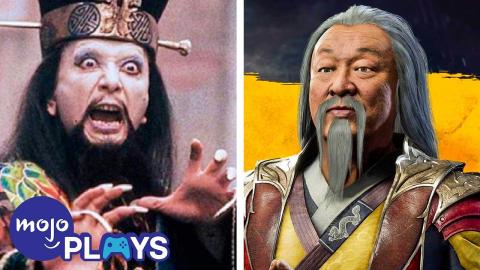Where There Mortal Kombat Characters Come From

advertisement
VOICE OVER: Adrian Sousa
WRITTEN BY: Mark Sammut
Mortal Kombat has a life and lore all of it's own, but a lot of it's characters are heavily based on other works of fiction, legends or even real life. So here are the best Mortal Kombat character origins.
Where Mortal Kombat Characters Come From
Welcome to MojoPlays! Today, we’re looking at the inspirations or stories behind certain “Mortal Kombat” characters.
Cetrion
Along with popular culture, "Mortal Kombat" is known for referencing religion of historical cultures while crafting its roster of deadly warriors. As the fourth Elder God to join NetherRealm's universe, Cetrion rules over Nature's four elements and life in general. Although the franchise typically refrains from creating direct parallels with any ancient deities, some connections can nevertheless be deduced. In the case of Cetrion, the most likely influencers are Ceres and Demeter, the Roman and Greek goddesses of agriculture and fertility respectively. Through their governance of nature and reproduction, Ceres and Demeter were responsible for creating life, a duty handled by Cetrion among the Elder Gods.
Goro
Out of all the characters included in 1992's "Mortal Kombat," one monster stood out from the otherwise human cast. For the most part, Midway adopted digitized sprites based on actors to actualize the early games' rosters, but Goro and subsequent monsters like Sheeva and Kintaro were stop-motion. In an interview with ARGcast, "Mortal Kombat" co-creator John Tobias named old monsters from films like "Clash of the Titans" as a launching pad for the legendary gaming villain. So, what about Goro's four arms? The monster's defining characteristic harbors back to "The Golden Voyage of Sinbad," a British fantasy film featuring a six-armed stop motion monster based on the Hindu deity: Kali.
Ermac
Prior to the rise of the internet and social media led to the widespread distribution of readily accessible information, players dependent on gaming magazines and their own imaginations. Unfortunately, both are known to be occasionally wrong. "Mortal Kombat's" diagnostics menu featured a listing entitled "ERMACS," which fans assumed referred to a secret character. Alas, it turned out that “ER MACS” actually stood for “Error Macros”, not a hidden character. Still, after years of speculation, "Ultimate Mortal Kombat III" decided it would be easier to create Ermac than to dispel any such rumors. Similarly, Skarlet started out as a rumoured glitched Kitana in "Mortal Kombat II;" unlike Ermac, Skarlet had to wait until Mortal Kombat 2011’s DLC to become a real fighter.
Sub-Zero & Scorpion
You cannot have "Mortal Kombat" without arguably the franchise's most iconic characters. Debuting in the original game and returning for almost every sequel, Scorpion and Sub-Zero are fierce rivals with eerily similar costumes and opposing elements at their disposal, creating an almost Yin-Yang dynamic between the two. While the pair's palette-swapped designs fit the narrative, Scorpion and Sub-Zero are a byproduct of the technological limitations faced by Midway. Since the same foundation serves as the base for both fighters, the developer could save memory as only one character needed to be created. Palette swapping proved so effective, Midway even threw in a third ninja, Reptile, as a bonus character.
Rain
Seeking to exhaust all the colors of the rainbow, "Mortal Kombat" has a yellow, blue, green, gray, and now a red ninja as mentioned earlier with Ermac. Considering the attract mode's intro shows a purple ninja named Rain, "Ultimate Mortal Kombat III" seemed to be have more in store; however, try as people might, the character could not be found in the actual game. While Rain eventually became playable in the home console releases, the ninja started out as a joke character inspired by Prince's "Purple Rain." As a fan of the legendary musician, Ed Boon, "Mortal Kombat's" co-creator, added Rain to mess a bit with players.
Liu Kang
Bruce Lee's presence can be felt across various mediums and gaming is no exception. "Soul Calibur," "Tekken", "Fatal Fury" and even "Pokémon" all boast characters reminiscent of the exceptional martial artist. In the case of "Mortal Kombat," this honor falls to the franchise's prominent hero Liu Kang, who resembles a digitized Bruce Lee in the first game. Along with the Shaolin monk's physical design, Kang can also transform into a dragon, a mythological creature synonymous with Bruce Lee. Originally, Kang was intended to be closer to a traditional bald monk, but actor Ho-Sung Pak preferred to keep his hair, so the dragon entered the scene.
Raiden & Shang Tsung
Many kung-Fu flicks and B-movies directly or indirectly assisted in defining "Mortal Kombat's" identity. That being said, the one source of inspiration most frequently cited has to be John Carpenter's "Big Trouble in Little China." "Mortal Kombat's" main villain, Shang Tsung, is heavily inspired by the film's own antagonist; David Lo Pan, whom both decrepit an old men seeking to obtain souls to extend their own lives. The comparisons do not end there, as the iconic Raiden is the spitting image of "Big Trouble in Little China's" Lightning character. While "Mortal Kombat's" Elder God is primarily based on Japan's deity of lightning and thunder, Raiden's hat is a deliberate nod to "Big Trouble in Little China."
Johnny Cage
Armed with sunglasses and a cheeky grin, Johnny Cage is a not so subtle allusion to Belgian actor Jean-Claude Van Damme. In fact, Cage's design in the original "Mortal Kombat" is basically identical to Van Damme's look in the 1988 martial arts classic "Bloodsport." A scene from the same movie also inspired Cage's "Split Punch" attack, a move later renamed as the "Nutcracker." "Mortal Kombat's" history with Van Damme goes back further than just Cage; originally, Midway wanted to create a fighting game starring the actor, although Van Damme rejected the idea.

